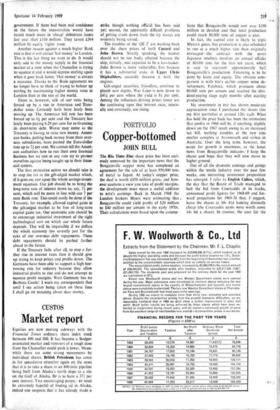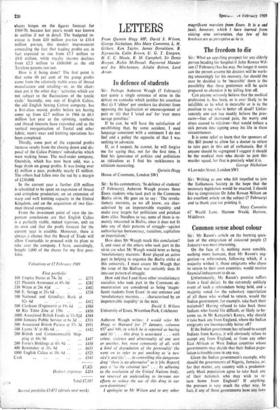Copper-bottomed
PORTFOLIO JOHN BULL
The -Rio Tinto Zinc share price has been curi- ously unmoved by the important news that the Bougainville copper mine has completed an agreement for the sale of at least 950,000 tons of metal to Japan. At today's copper price, the deal is worth f450 million gross, and how- ever cautions-a view you take of profit margins, The development 'must -mean a useful addition to arrz's earnings. Back in March 1968 the London brokers Myers were estimating that Bougainville could yield profits of $20 million to $40 million per annum in the early 1970s. Their calculations were based upon the assump-
tions that Bougainville would cost over $100 million to develop and that total production could reach 80,000 tons of copper a year.
In fact, the capital cost is likely to triple Myers's guess, but production is also scheduled to run at a much higher rate than originally envisaged-the contract with the seven Japanese smelters involves an annual offtake of 80,000 tons for the first ten years, which is said to represent approximately half Bougainville's production. Financing is to be done by loans and equity. The obvious com- parison is with art's earlier copper mine de- velopment, Palabora, which produces about 80,000 ions per annum and reached the divi- dend-paying stage eight months after starting production.
My investment in RTZ has shown moderate appreciation since I purchased the shares (for my first portfolio) at around 120s each. What has held the price back has been the intimation that profits in 1968 will be, if anything, slightly down on the 1967 result owing to an increased tax bill, teething troubles at the new zinc smelter complex at Avonmouth and strikes in Australia. Over the long term, however, the scope for growth is enormous, as the latest mews from Bougainville indicates. I keep the shares and hope that 'they will now move to higher ground.
Out of -all the dramatic comings and goings within the textile industry over the past few weeks, one interesting investment proposition has emerged. I refer to English Calico, which, the day that the Board of Trade managed to halt the bid from Courtaulds in its tracks, announced profit .figures for 1968-69 and for- ward projections for 1969-70 that, 1 suggest, leave the shares .at 10s 44c1 looking distinctly cheap (the Courtaulds terms -were worth some 14s 6d a share). In essence, the case for the shares binges on the figures forecast for 1969-70, because last year's result was known in outline if not in detail. The budgeted in- crease is from £10 million pre-tax to £10.4 million pre-tax, this modest improvement concealing the fact that trading profits are in fact expected to rise from £7.7 million to £9.8 million, while royalty income declines from £2.3 million to £600,000 as the old Terylene patents run out.
How is it being done? The first point is that some 60 per cent of the group profits come from the relatively stable areas of thread manufacture and retailing—or, as the chair- man put it the other day : 'activities which are not subject to the fluctuations of the textile cycle.' Secondly, one side of English Calico, the old English Sewing Cotton company, has a first-class record, profits before tax having come up from £2.7 million in 1966 to £6.1 million last year as the spinning, synthetic and thread interests have expanded and as the vertical reorganisation of Tootal and other fabric, men's wear and knitting operations has been completed.
Thirdly, some part of the expected profits increase results from the closing down and dis- posal of the Calico Printers' subsidiaries which were making losses. The mail-order company, Oxendale, which has now been sold, was a huge drain on group profits. It was losing over £1 million a year, probably nearly £1 million. The others had fallen into the red by a margin of £230,000.
In the current year a further £10 million is scheduled to be spent on expansion of thread and crimplene production, on an extension of warp and weft knitting capacity in the United Kingdom, and on the acquisition of two Ger- man thread companies.
From the investment point of view the im- portant conclusions are that English Calico is a perfectly viable, indeed vigorous, unit on its own and that the profit forecast for the current year is credible. Moreover, there is always a chance that the Board of Trade will allow Courtaulds to proceed with its plans to take over the company. I have, accordingly, bought 1,000 of the shares for my first port- folio.
Valuations at 12 February 1969
First portfolio-
100 Empire Stores at 74s 3d .. £371 125 Phoenix Assurance at 45s Od £282 330 Witan at 24s £402 500 E. Scragg at 21s 6d £538 100 National and Grindlays Bank at 82s 6d £412 500 Clarkson (Engineers) at 19s 6d £488 60 Rio Tinto Zinc at 150s £450 1000 Associated British Foods at I Is 81d £584 1000 Jamaica Public Service at 6s 3d .. £313 500 Associated British Picture at 37s 3d £931 100 Lyons 'A' at 88s 6d £442 200' British and Commonwealth Ship- ping at 44s 9d 1447 200 Forte's Holdings at 45s 9d .. £458 400 Bowmaker at 3Is 9d £635 1000 English Calico at lOs 6d .. £525 Cash 1143 £7,421 Deduct: expenses £334 Total £7,187 Second portfolio f5,871 (details next week)



































 Previous page
Previous page